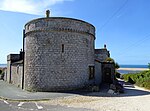Alexander (1803 ship Bombay)
1803 shipsAge of Sail merchant shipsMaritime incidents in 1815Merchant ships of the United KingdomShip infoboxes without an image ... and 1 more
Shipwrecks in the English Channel
Alexander was a merchant vessel launched at Bombay in 1803. She was shipwrecked in 1815 while on passage from Bombay to London two miles (3 km) from the Isle of Portland on the Dorset coast in the English Channel. Only five of the ship's 140 (or 150) crew and passengers survived the disaster.
Excerpt from the Wikipedia article Alexander (1803 ship Bombay) (License: CC BY-SA 3.0, Authors).Alexander (1803 ship Bombay)
Rodwell Trail,
Geographical coordinates (GPS) Address Nearby Places Show on map
Geographical coordinates (GPS)
| Latitude | Longitude |
|---|---|
| N 50.584 ° | E -2.47 ° |
Address
Rodwell Trail
Rodwell Trail
DT4 9XS
England, United Kingdom
Open on Google Maps









